Opening date July 2, 1967 Closed 21 August 1995 Vehicles 62 | Status SBNO Closing date August 21, 1995 Opened 2 July 1967 Park Disneyland Manufacturer Walt Disney Imagineering | |
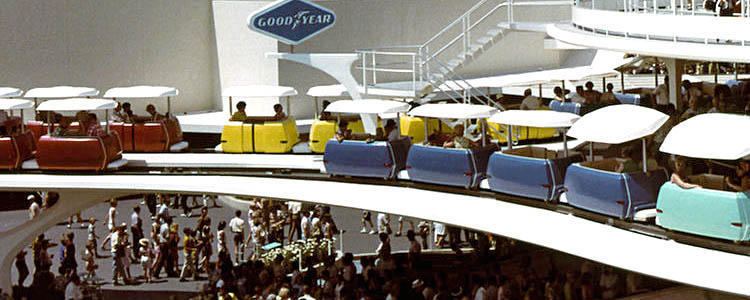 | ||
Similar Tomorrowland Transit Authority, Skyway, Walt Disney's Carousel, Rocket Rods, Astro Orbiter | ||
Disneyland peoplemover complete ride with original narration
The PeopleMover, sometimes referred to as the Goodyear PeopleMover and WEDWay PeopleMover, was a transport attraction that operated from July 2, 1967 to August 21, 1995 in Tomorrowland at Disneyland in Anaheim, California. Guests boarded small trains that ran on elevated tracks for a "grand circle tour" above Tomorrowland. The ride's station and track infrastructure remain standing but not operating. A second PeopleMover, known as the WEDway PeopleMover, of a somewhat different design, opened at the Magic Kingdom in Walt Disney World, Florida in 1975, and operated from 1994 to 2009 as the Tomorrowland Transit Authority until being renamed "Tomorrowland Transit Authority PeopleMover" on August 5, 2010, and is still operating today.
Contents
- Disneyland peoplemover complete ride with original narration
- Disneyland peoplemover 1990
- Operation
- Sponsorship
- History
- SuperSpeed Tunnel
- Deaths and incidents
- Closure
- References
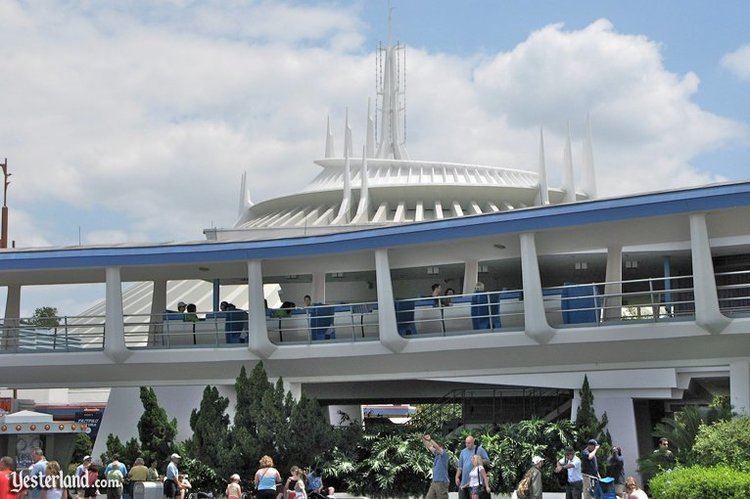
The term "people mover", now in wider use to describe many forms of normally automated public transport, was first coined as the name for this attraction. PeopleMover was originally only a working title but became attached to the project over time. Originally the attraction was seen as a serious prototype for intra-city public transport.
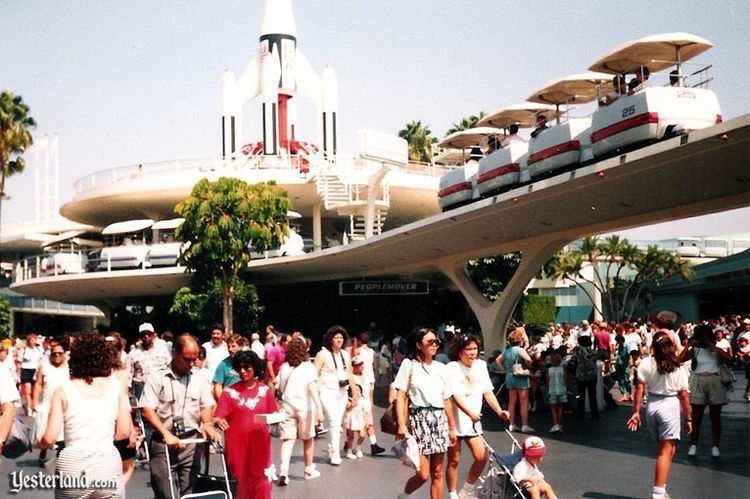
Disneyland peoplemover 1990
Operation
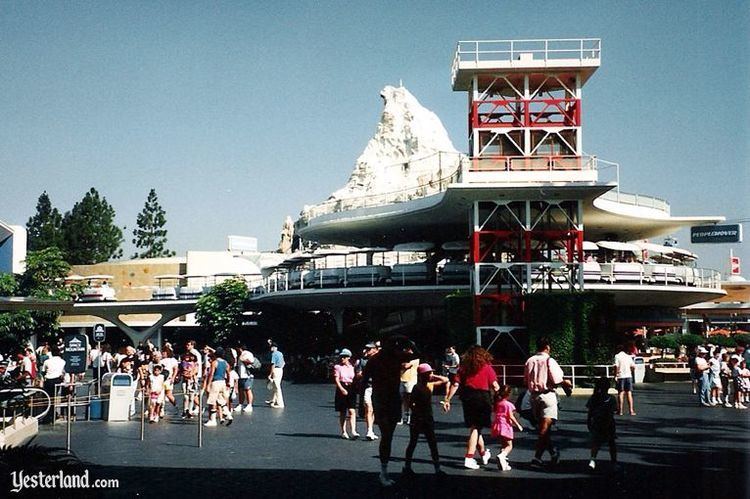
The attraction's vehicles were always moving. Passengers boarded and alighted by a large speed-matched rotating platform inside the station. The trains were not powered by motors within themselves, but rather by being pushed by rotating tires each with its own electric motor, embedded in the track once every nine feet.

Each car included its own sound system which broadcast a continuous audio commentary and soundtrack, relative to the train's location. The commentary pointed out Disneyland's attractions along the way as well as announcing promotional items.

The tour continued from the center of Tomorrowland through a few of Tomorrowland's buildings, for a look inside, and over Disneyland's Submarine Lagoon and Autopia areas, before returning to Tomorrowland.
Sponsorship
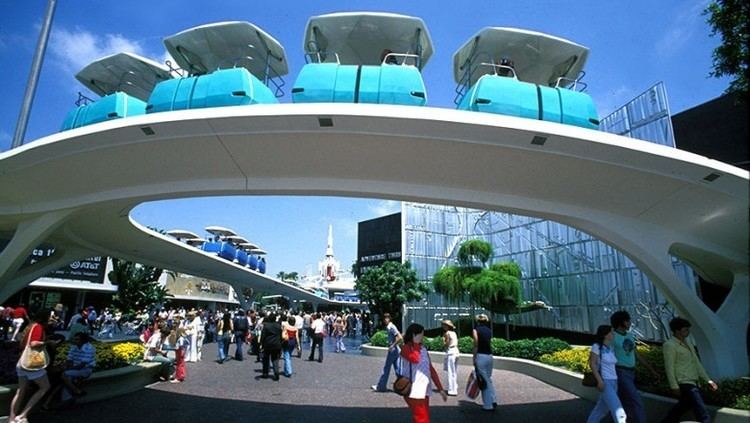
The attraction used an updated WEDway system based on the WEDway used for the Ford Magic Skyway at the 1964-65 New York World's Fair. When Disney asked Ford Motor Company to continue sponsorship by sponsoring Disneyland's new PeopleMover, they declined, because Ford was reluctant to support technology that appeared to replace the automobile. Goodyear was then approached to sponsor it, and accepted. The wheels used in the WEDway system were replaced by Goodyear's tires. The PeopleMover's logo was then fashioned after Goodyear's logo, sharing a similar type face. Goodyear sponsored the PeopleMover from its opening until December 31, 1981. However, Goodyear's instrumental "Go Go Goodyear" advertising jingle still served as part of the attraction's soundtrack until at least 1990.
History
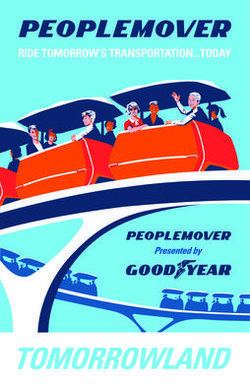
The PeopleMover opened as part of New Tomorrowland in 1967. Originally, each four-car train was colored either red, blue, yellow or green with white roofs. They were repainted all white with colored stripes in 1987. In 1968, each of the 62 trains were retrofitted with safety rails for each car, to deter guests from climbing out. They 'semi' wrapped around each car. In 1985, these safety rails were modified to completely wrap around each car, making it even more difficult for possible accidents to occur.
SuperSpeed Tunnel
In 1977, the SuperSpeed Tunnel was added to the PeopleMover. It was located in the upper level of the Carousel Building, which then housed America Sings. Race cars were projected on the walls of the tunnel all around the trains. In 1982, the projections were changed to scenes from the film Tron and the tunnel was announced as the Game Grid of Tron by the on-board audio guide. After this addition, the attraction was advertised as the "PeopleMover Thru the World of Tron."
Deaths and incidents
In August 1967, a 17-year-old boy from Hawthorne, California, was killed while jumping between two moving PeopleMover cars as the ride was passing through a tunnel. He stumbled and fell onto the track, where an oncoming train of cars crushed him beneath its wheels and dragged his body a few hundred feet before it was stopped by a ride operator. The attraction had only been open for one month at the time.
In 1972, four teenage girls were riding the People Mover when one teenager lost her mouse ears cap. She and her cousin jumped onto the track to retrieve them. Realizing they'd have to get on a different PeopleMover car, the first girl successfully got into a car, while the second girl ran through a tunnel and out the exit and then fell into a guard rail and onto the concrete 30 feet below. She broke an arm, hip, and pelvis; she had to be in a body brace and have a pin inserted into her leg. She sued Disney for not having any warnings about the exit.
On June 7, 1980, an 18-year-old man was crushed and killed by the PeopleMover while jumping between moving cars. The accident occurred as the ride entered the SuperSpeed tunnel.
Closure
The PeopleMover closed in August 1995 since Imagineers thought the ride was past its time and no longer a prototype, but rather a place to rest one's feet and also as part of Michael Eisner's program to save money by shutting down expensive and classic attractions. It was replaced by the short-lived Rocket Rods in 1998.
A few of the retired PeopleMover cars were used in other parts of the resort after its closing. Three cars from train #45 used to sit outside the Team Disney Anaheim building, but they were removed in 2007. One of the cars from train #45 is now in display at the cast members cafe called the Eat Ticket. Another car from train #45 is now in the hands of a local resident. Two cars were repainted with a blue and orange grid to resemble a blueprint (along with Rocket Jets vehicles and the front of a Mark III Disneyland-ALWEG monorail train) and placed in the queue display for Rocket Rods, which would later close in 2000. These were later sold on Disney Auctions after Rocket Rods closed.
The checkout counters at the Little Green Men Store Command in Tomorrowland resemble PeopleMover cars and the store has former Rocket Jets vehicles retrofitted as merchandise shelves. The store also had Skyway buckets hanging from the ceiling when it was the Premiere Shop.
In 2000, almost five years after the attraction's closure, an updated version of the Autopia attraction opened. The old on-board audio music from the PeopleMover now serves as the background area music in Autopia's queue.
The ride track infrastructure which served both the PeopleMover and Rocket Rods still stands unused in Tomorrowland. The track, however, is still being maintained, as it was repainted in 2005 along with the rest of Tomorrowland, and foliage over the Autopia area was trimmed away or removed from the track. In September 2010 at D23's "Destination D" event, then-president of Disneyland Resort George Kalogridis said that while there may be plans to bring back the ride, the park would not be able to return the attraction to its original form due to stricter regulations. Kalogridis stated "Everyone understands the passion everyone has for it." He additionally stated, "Hang in there."
